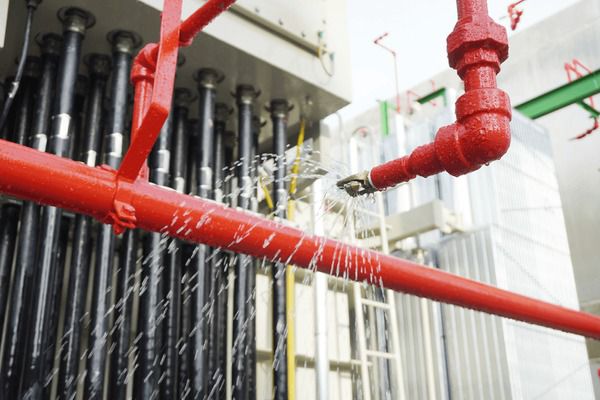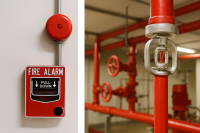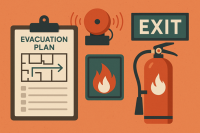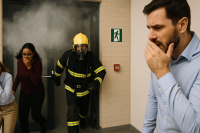
Fire sprinkler systems play a crucial role in modern fire protection strategies, significantly reducing fire risks in residential, commercial, and industrial buildings. By detecting and suppressing fires early, sprinkler systems help prevent catastrophic damage and, most importantly, save lives. In this article, we will explore the importance of fire sprinkler systems, how they function, the different types available, and the key benefits they offer in fire risk mitigation.
Importance of Fire Sprinkler Systems
Fire sprinkler systems are one of the most effective tools for fire suppression. According to studies by fire safety organizations worldwide, buildings equipped with sprinklers are much less likely to experience significant fire damage compared to those without them. The National Fire Protection Association (NFPA) in the U.S. reports that the combination of sprinklers and alarms in a building can reduce fire-related deaths by more than 80%.
In Indonesia, where urbanization is rapidly increasing and high-density buildings are common, fire sprinkler systems are especially critical. The early detection and suppression of fires help protect not only property but also human lives in crowded environments. This makes sprinklers a key element of fire safety compliance, especially in high-rise buildings, shopping malls, hospitals, and factories.
How Fire Sprinkler Systems Work
Fire sprinkler systems operate on a simple yet highly effective principle: detecting heat and automatically discharging water to control or extinguish fires. While people often mistakenly believe that sprinkler systems release water throughout an entire building when activated, in reality, only the sprinklers closest to the fire are triggered.
Each sprinkler head contains a glass bulb or a heat-sensitive fusible link that holds back water under pressure. When the temperature at the sprinkler head reaches a certain threshold (usually between 135-165°F or 57-74°C), the bulb bursts or the link melts, allowing water to flow out and suppress the fire. The water not only controls the flames but also cools the surrounding area, preventing the fire from spreading.
Types of Fire Sprinkler Systems
There are various types of fire sprinkler systems designed to cater to different environments and fire risks. Each system has specific advantages depending on the building type, climate, and hazards involved.
- Wet Pipe Systems
The most common type of sprinkler system, wet pipe systems contain water in the pipes at all times. When a sprinkler head activates, water is immediately discharged onto the fire. These systems are cost-effective and reliable, making them suitable for most commercial and residential buildings. - Dry Pipe Systems
In dry pipe systems, the pipes are filled with pressurized air or nitrogen rather than water. When a sprinkler head opens, the air is released, allowing water to flow through the pipes. Dry pipe systems are typically used in areas where freezing temperatures could cause water-filled pipes to burst, such as warehouses or outdoor parking structures. - Deluge Systems
Deluge systems feature open sprinkler heads that release water all at once when a fire is detected. These systems are used in high-hazard environments, such as chemical plants or power stations, where fires can spread quickly and require a large volume of water for suppression. - Pre-Action Systems
A hybrid of wet and dry pipe systems, pre-action systems require two events to occur before water is released: a fire detection alarm must first trigger the system, and then the sprinkler head must activate. These systems are used in sensitive areas, such as museums or data centers, where accidental water discharge could cause significant damage.
Benefits of Fire Sprinkler Systems
Fire sprinkler systems offer numerous benefits beyond just controlling fires, making them an integral part of building safety and fire risk management.
- Rapid Response to Fires
Sprinklers activate quickly upon detecting a fire, often before it has time to grow out of control. This immediate response prevents the fire from spreading and limits both property damage and the risk to occupants. - Life-Saving Potential
By suppressing a fire in its early stages, sprinkler systems provide more time for building occupants to evacuate safely. In buildings without sprinkler systems, fires can grow rapidly, leaving less time for escape. In Indonesia’s densely populated urban areas, this extra time can be the difference between life and death. - Minimizes Property Damage
While sprinklers do release water, the amount is significantly less than what firefighters would use to extinguish a fully developed fire. By containing the fire early, sprinklers reduce the need for extensive firefighting efforts, which can cause additional damage to the building. - Lower Insurance Costs
Buildings equipped with fire sprinkler systems are generally considered lower risk by insurance companies, leading to lower premiums for property owners. This financial benefit adds another incentive for installing and maintaining these systems. - Compliance with Fire Safety Regulations
In many regions, including Indonesia, fire sprinkler systems are required by law in certain types of buildings. Installing sprinklers helps developers and building owners meet local fire safety codes and ensures that structures are compliant with regulations, avoiding potential fines or legal issues.
Conclusion
Fire sprinkler systems are indispensable for reducing fire risks in modern buildings. By offering quick detection and suppression, these systems play a vital role in saving lives, protecting property, and preventing fire from spreading. Whether through wet pipe, dry pipe, or more specialized systems, sprinklers are a cost-effective solution for enhancing fire safety in Indonesia’s increasingly urban environment. As the country continues to grow, investing in reliable fire protection systems will be essential to ensuring that both people and property are safeguarded from the dangers of fire.





Leave A Comment